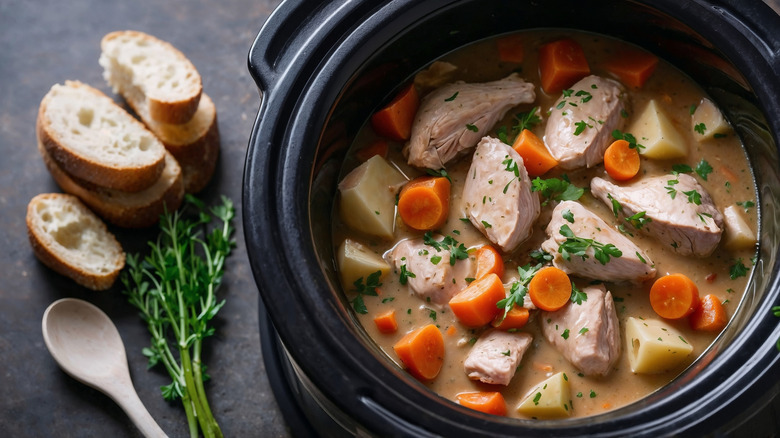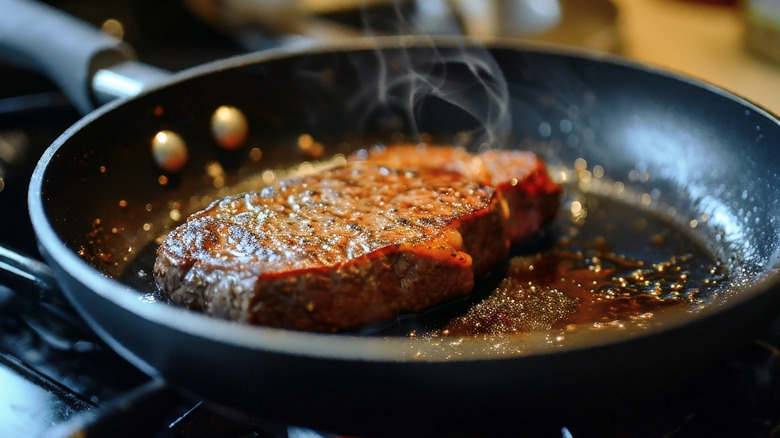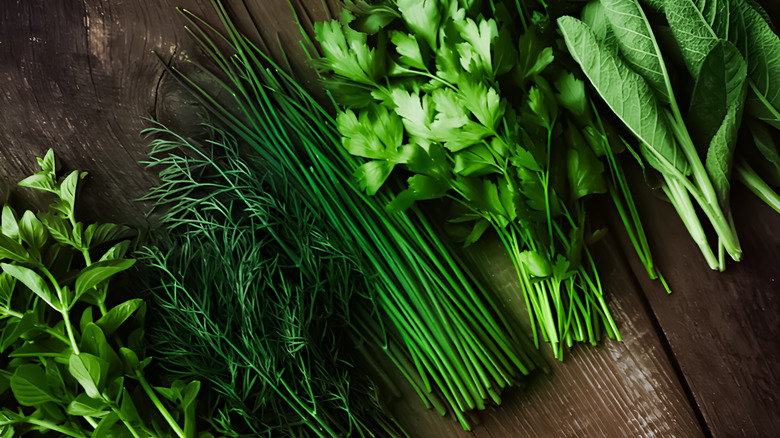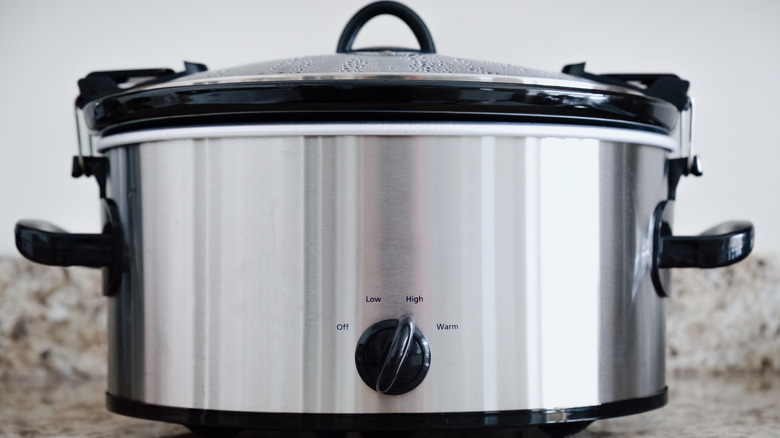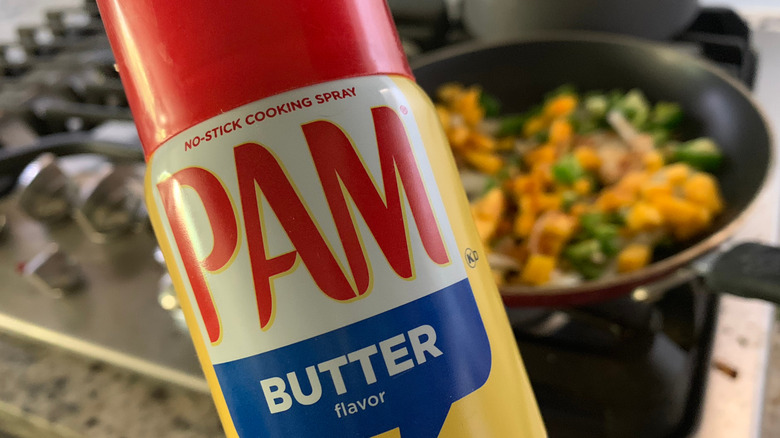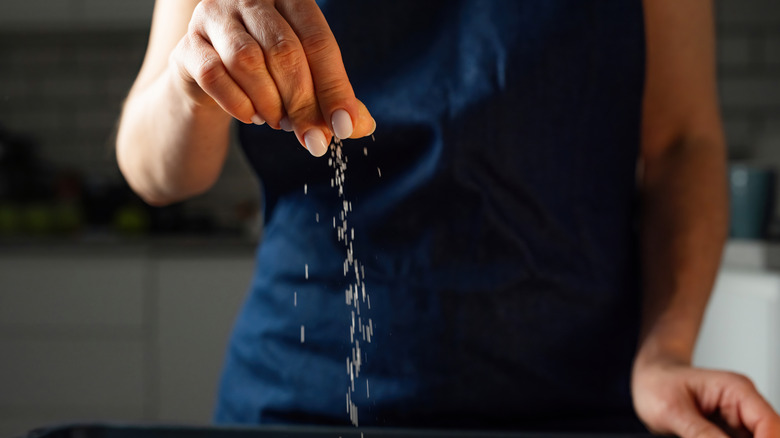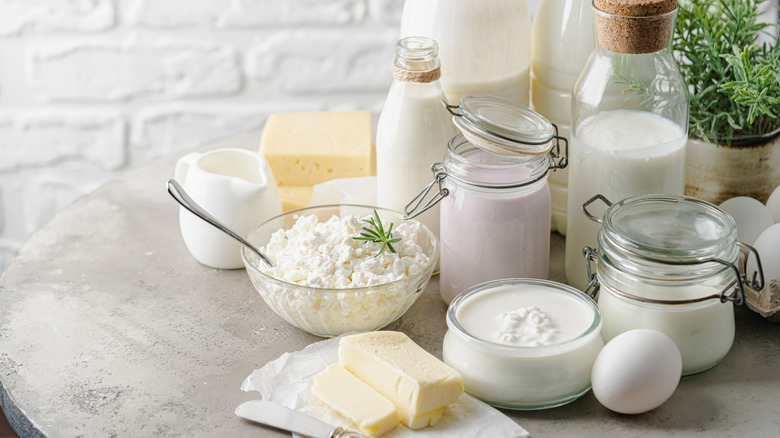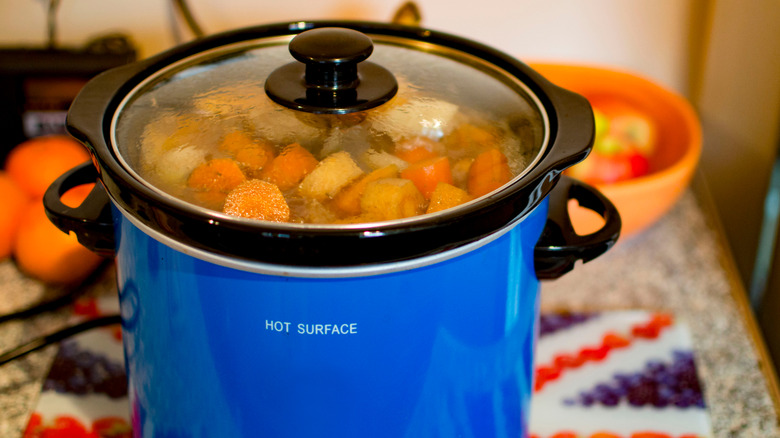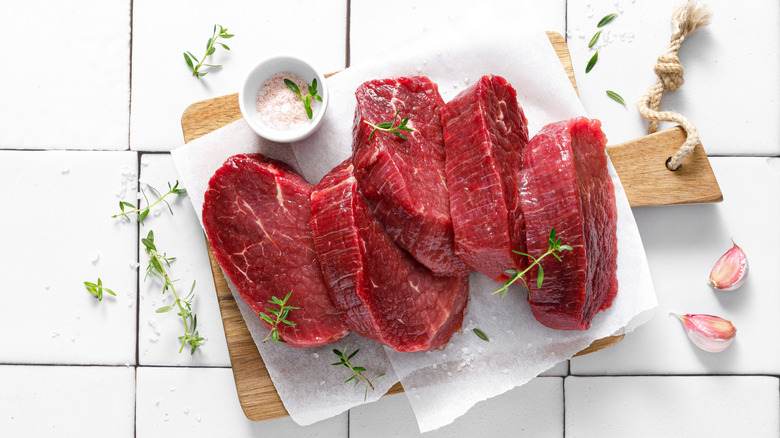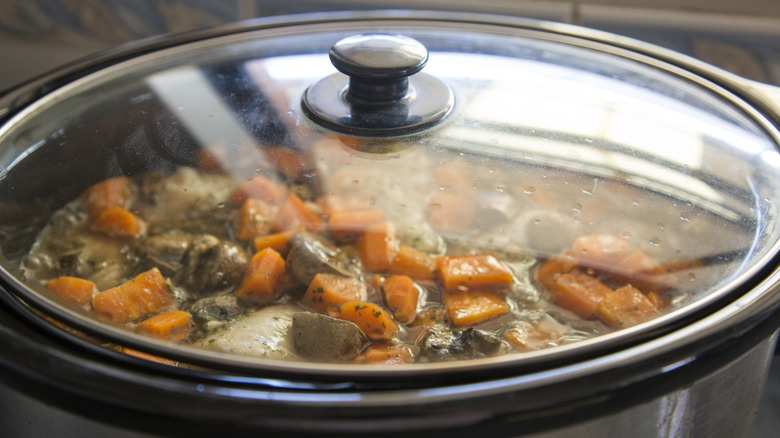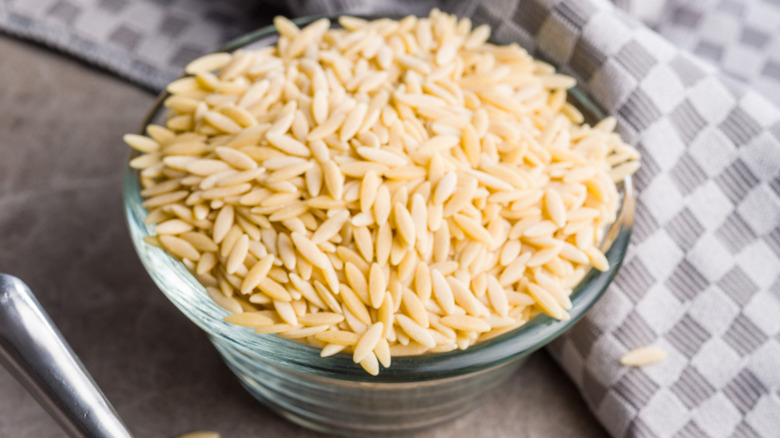Common Slow Cooker Mistakes That Are Ruining Your Food
A slow cooker meal is always satisfying, and tastes especially comforting after a long day at work. The convenience this hard-working appliance provides is unparalleled, and allows you to put a warm dinner on the table in just a matter of minutes. One of the best aspects of using a slow cooker is that you can prep all of your recipe ingredients, including meat and various types of produce and fresh herbs, in the morning, add it to the pot, select your heat level, and then just simply go about your day. In a way, having a slow cooker is like coming home to a personal chef who prepared your favorite dish while you were out and about.
Even though a slow cooker is easy to use and requires minimal effort to operate, there are still some "dos' and "don'ts" you need to consider. While some mistakes, such as adding certain ingredients at the wrong time, can affect the taste and overall quality of the food, others may totally ruin it. There's nothing more disappointing than expecting to serve up a delicious slow cooker meal but realizing that it belongs in the trash instead of your plate. So follow these tips to ensure you won't have to end up ordering pizza the next time you use your slow cooker.
Not defrosting your frozen meat first
While it may be tempting to grab frozen meat, such as chicken breast or steak, from the freezer and throw it into your slow cooker, it's actually not a good idea for several reasons. Before you attempt to use frozen leftover (or any type of) meat in a stew or soup you're making, consider the safety hazards. Although a slow cooker's maximum temperature of between 170 and 280 degrees Fahrenheit is high enough to kill off dangerous bacteria, the U.S. Department of Agriculture states that placing frozen meat in a slow cooker will allow it to hang out in the thaw zone for too long, where bacteria can rapidly multiply.
The temperature range in which bacteria quickly grows is between 41 and 135 degrees Fahrenheit and a moist environment, such as a slow cooker filled with broth, will make the situation even more risky. Meat that is slowly thawing out in the appliance may linger in the bacteria "no zone" for too long, putting you at risk for food poisoning.
It's worth taking the time to fully thaw all meat before placing it into the slow cooker by placing it in the refrigerator overnight, or defrosting meat in your microwave. This will also ensure that the food cooks all the way through.
Failing to sear your meat before putting it into the appliance
As long as your meat is thawed, you can safely throw it into slow cooker with the other ingredients. If you have a few extra minutes, however, consider searing it first. Not only will searing meat give you a head-start on the cooking process, it'll also make it more flavorful.
Searing your meat will also give it an appetizing color and appearance, even after it's been in the slow cooker for a few hours. After searing the meat, such as a steak or pork chops, you can then add the fat drippings in the pan to the slow cooker for even more depth and rich flavor.
Searing meat makes it taste delicious due to the Maillard reaction, which is the process during which heat, along with the sugar and protein content, react to each other. The chemical reaction results in the meat having a deeper, more intense taste, as well as an aesthetically pleasing golden brown color. The high heat of the searing enhances the meaty, umami-rich flavors before the protein is slow-cooked until fall-apart tender. Sear your meat in an oiled frying pan or grill, flipping it once halfway through the process so that it's brown on each side.
Adding delicate vegetables and herbs too early
Adding fresh herbs and delicate vegetables to your slow cooker can add brightness and vibrancy to the dish. Knowing when to throw them in the pot is essential, however. If you add soft vegetables, such as tomatoes, zucchini, spinach, and peas, too early, they'll end up overcooked with a mushy, unappealing taste and texture.
When using a variety of ingredients, it's best to layer them according to their recommended cooking time. For instance, root vegetables should be at the bottom, followed by meat, and then the delicate vegetables on top. Softer vegetables typically require approximately 30 to 60 minutes in the slow cooker. Add any fresh herbs, including basil, dill, parsley, and oregano, at the very end, so that they retain their vibrant color and flavor.
For an even more intense taste, add dried herbs to the slow cooker at the beginning of the process, along with salt and pepper. You can then use the same fresh herbs at the end to enhance the flavor. After adding the delicate vegetables to the appliance, adjust the slow cooker's temperature to "low." Monitor the vegetables' firmness, and adjust the heat setting or cook time as needed. For a pop of color, sprinkle chopped fresh herbs over the food after it's served.
Keeping your food on the slow cooker's warm setting for too long
Your slow cooker's "warm" setting is a handy tool during parties when you want to keep soup or stew hot while guests eat, mix, and mingle, but there can be too much of a good thing. There are several reasons why allowing the appliance to linger on warm is a slow cooker mistake that can make your food unsafe to eat.
A slow cooker's "warm" setting typically hovers around 140 degrees Fahrenheit, which is just inside what the USDA calls the "danger zone" of 40 and 140 degrees Fahrenheit. In this temperature range, bacteria in the food can rapidly multiply, putting you at risk for a foodborne illness. If you know you'll be out of your home for a specific number of hours, such as an eight-hour work day or four-hour trip, use a recipe that you can cook on the appliance's "low" or "high" setting during that entire duration.
Another reason that keeping your slow cooker on "warm" for too long isn't ideal is that it can ruin the flavor and texture of your food. For instance, if you allow your food to sit on this setting for four to six hours, even the hardiest of root vegetables and grains may get mushy, and meat can get tough. Also, if you're making a soup or another saucy recipe, it can end up being too thick, or even dry out completely if the liquid reduces too much.
Not greasing the appliance to prevent sticking
Since you're not frying or baking food in your slow cooker, you may think you don't need to grease the appliance. That may be a mistake that leads to a sticky, hard-to-remove mess at the end of the day, however. The main point of using a slow cooker is convenience, so the last thing that you want to do is make a mess that you'll have to clean up later.
Oiling the slow cooker's crock before placing food in it is an essential step, especially if you're preparing food without a lot of liquid, such as lasagna or cakes, or if you're warming up starchy food like mashed potatoes. If you're cooking something saucy like soup or stew, you won't need to use extra oil.
One easy way to grease your slow cooker's crock is with a nonstick cooking spray. As an alternative, you can wipe the inside of the crock with another type of fat, such as butter, olive, vegetable, or coconut oil. After coating the crock, you can then continue with your recipe. If you're making baked goods such as brownies in your slow cooker, lining the inside with a baking paper or liner is another option.
Salting the food too much at the beginning
Another slow cooker mistake that can turn your dinner from delicious to disgusting is using too much salt at the beginning of the cooking process. Although you may worry that your dish is going to turn out to be bland, it's better to err on the side of caution when using salt. Using a heavy hand may make your food too salty to enjoy, and it's much easier to add the seasoning as needed, rather than try to remove an excess amount at the end.
It's important to keep in mind that salt may be hidden in other ingredients you're adding to your slow cooker, too. Foods such as packaged and canned broths, bottled gravies, soups, and seasoning packets all have a salt content and can quickly make your dish go from the perfect amount of salinity to too much.
What can you do if you've oversalted your slow cooker recipe at the beginning? Potatoes to the rescue. If you add raw, peeled potato to your soup or stew, it will help absorb excess salt. The only problem with that technique is that it can also absorb too much liquid, making your dish too dry. In that case, add a bit more water or broth. Other ways to counteract overly salty food include adding a bit of sweetness or a touch of acid, such as lemon juice. Adding some fat, including butter or heavy cream, may also do the trick.
Adding dairy before the very end
It's no secret that dairy products can make your slow cooker meal even more lush and delicious, but knowing when to add them makes all the difference. Many types of ingredients, such as meat and hardy vegetables such as beets, potatoes, and carrots, can benefit from longer cooking times — but dairy products aren't on that list.
Cream, milk, buttermilk, sour cream, yogurt, and other dairy items can break down and curdle when exposed to heat for too long, due to their proteins attracting each other and forming curds. The last thing you want is curdled milk when you're trying to create a smooth, creamy sauce or soup. Dairy items can also separate when exposed to heat for an extended period, resulting in a greasy mess.
So what can you do to ensure a rich and luscious result? Simply add any desired dairy products to your slow cooker during the last 15 or 30 minutes of the cooking process, or you can add cheese to the slow cooker an hour before serving the dish. You can even add the dairy last-minute if you prefer, as it'll just need to heat up rather than cook since it's not raw. As one idea, canned milk makes slow cooker soups extra rich. A dollop of sour cream on top of your prepared dish is another option.
Overfilling your slow cooker
Another issue that may be killing your slow cooker game is overfilling your appliance. Not only can stuffing your slow cooker to the brim cause your ingredients to not cook correctly and thoroughly, it may also result in a big, hot mess. Having too many food items in the appliance can make any liquid in the crock boil over and spill out even under a tight lid. Even if it doesn't sneak out when the lid is closed, you could have an epic disaster when you open it.
Make sure to heed the appliance manufacturer's warning, and don't go over the max fill line. It's best to take your time when filling your slow cooker, layer all of your ingredients in a particular order, and then top it with just enough liquid to aid the cooking process.
Fill your slow cooker in layers, placing sturdy root vegetables and meat at the bottom, working your way up to delicate spring vegetables and fresh herbs at the top. Don't use more liquid than the recipe calls for, as it won't evaporate due to the appliance's closed lid. The golden rule is to fill the appliance no more than two-thirds full, if possible. It's better to leave too much room in the cooker rather than not enough.
Putting lean meat and seafood into the appliance
Another slow cooker no-no is using lean meat or delicate seafood, such as small shrimp or scallops, in your recipe. While it may sound tempting to use them if you're aiming for a lighter dish or are a shellfish lover, neither type of ingredient is recommended for a low and slow cooking method. Protein with a minimal fat content tends to dry out and become tough when cooked over an extended period of time.
For the best results, keep leaner cuts of meat such as pork and steak fillets, and chicken breast, out of your slow cooker and put them in a frying pan or oven, or on a grill instead. According to experts, lean cuts of steak should only be cooked rare.
On the other hand, fattier and tougher proteins, including sinewy joints of meat like oxtail and pork shoulder, cook down over time, becoming tender bites that will melt in your mouth. Other types of collagen-rich meat that do well in a slow cooker include lamb shanks, short ribs, and chuck roasts, as well as dark meat chicken like thighs and drumsticks. You can also use ground meat with a higher fat content, such as 80/20, and make sure to fully cook ground beef in a slow cooker.
Opening the lid during the cooking process
Yes, the smell of a slow cooker meal simmering all day smells amazing, and you may want to check its progress repeatedly, but try to use restraint. Lifting the appliance's lid results in the loss of heat and moisture, adding as much as 20 minutes of cooking time each time you peek. Unless the recipe specifically tells you to do it, there's no need to stir ingredients once they're in the slow cooker.
The slow cooking method is designed to work without any interaction for hours at a time. When the appliance's lid is sealed, the heat creates steam that slowly cooks the ingredients. Opening the lid will release the much-needed steam and cause it to evaporate. If you want to be able to see what's going on as your food cooks, choose an appliance with a clear glass lid.
The only time opening the lid is a good idea is if you want to thicken up a slow cooker dish like beef stew, soup, or a sauce. If you need to remove some moisture from the food, you can either partially or completely open the lid to allow steam to escape. This technique may be especially beneficial during the last 30 minutes of the cooking process.
Adding starchy foods too early
Although starchy ingredients such as pasta and rice can make a delicious addition to your slow cooker recipe, adding them to the appliance at just the right time is the secret to soup or stew success. This is another time that the layering technique comes in handy, as you can start with heartier ingredients, including sturdy produce and tough cuts of meat, and then work your way up to the starches.
Even though it's easy to prepare a perfectly prepared dish in a slow cooker, adding starchy ingredients too early can result in them being over-cooked. And no matter how mouthwatering your jambalaya, gumbo, or stew is, mushy rice or pasta can quickly make it garbage-worthy.
It's also important to use the recommended amount of liquid, including broth, water, or milk, in the dish. Starches quickly soak up liquids, and if you haven't added enough, your dish may be too dry. The texture of the starchy ingredients will also be off if they don't have enough liquids to cook in. That problem is easy to fix, however, because you can test the rice or pasta at the end of the cooking process, and add more liquid if necessary. Alternatively, add cooked and drained pasta just before serving instead.
